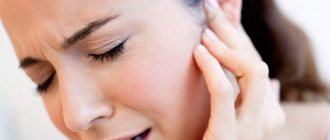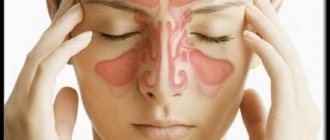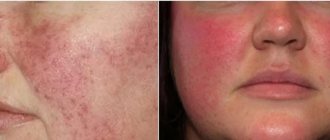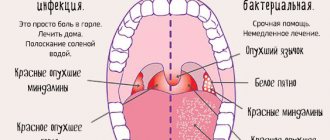Why does the bone under the eye hurt?
Pain under the eye may indicate an ophthalmic disease.
In this case, it is accompanied by a burning sensation, profuse lacrimation, swelling and double vision (diplopia), blurred vision, decreased visual acuity, dryness and itching. Occurs at rest, when pressing or blinking.
The causes of pain near the nose under the eye are varied - from mechanical effects (trauma) to purulent osteomyelitis. To determine the cause of the condition, the help of an ophthalmologist, otolaryngologist, neurologist and other specialized specialists is necessary.
Causes
Factors leading to pain:
- Mechanical injuries in the area of the nose, cheekbones and organ of vision - in addition, the patient is concerned about swelling, hematoma formation, and hemorrhage. First aid for this condition is cold, sleep sitting or the head should be in an elevated position to enhance the outflow of blood from the hematoma. For abrasions, treatment is carried out with hydrogen peroxide.
- Osteomyelitis is a purulent inflammation of the bone marrow, which often occurs due to untimely treatment of oral infections or improper dental care. The pain under the eye is aching and can radiate to the ear and cheekbones.
- Various vascular disorders, including glaucoma, can cause bone pain under the eye. The symptom may also be localized in the eyebrow area. Additionally, pain in the eyes, increased intraocular pressure, discomfort around the eyes, blurred vision, nausea and general weakness may be a concern. To treat the cause, the help of an ophthalmologist and cardiologist is required.
- Excessive strain on the visual muscles can lead to pain. This could be working at a computer, watching TV, reading in inappropriate conditions. Additional symptoms are increased fatigue, pain in the eyes, decreased visual acuity.
- One of the reasons is infectious processes in the area of vision, hearing, and nose. This is due to the proximity and possible transmission of infection. For example, conjunctivitis, accompanied by redness of the whites, purulent secretion, itching and tearing. With uveitis, there is aching and pain when moving the eyeballs.
- Trigeminal neuralgia can occur as a result of hypothermia, unresolved dental problems, or infections. At first, the patient feels as if the pain is radiating to one of the jaws. It then appears under the eye. Most often, neuralgia occurs after 40 years, mainly in women.
- A runny nose and sinusitis can also cause pain under the eye. Swelling of the nasal mucosa leads to compression of the surrounding tissues, resulting in pain. Possible increased intraocular pressure, lacrimation, swelling under the eyes, squeezing pain.
Drug treatment
Treatment will be prescribed in accordance with the diagnosis. These can be either simple nasal vasoconstrictor drops for a runny nose or powerful antibiotics if pain in the eyebrow has become a symptom of an inflammatory process. In the most severe cases (the same advanced sinusitis), surgical intervention is possible. And before visiting a doctor, you can give yourself the following first aid in order to somehow relieve the pain.
NSAIDs - non-steroidal anti-inflammatory drugs
These are first aid remedies for eyebrow pain of unknown etiology. They have analgesic and anti-inflammatory effects. These include drugs that contain:
- metamizole sodium (Analgin, Baralgin);
- acetylsalicylic acid (Upsarin Upsa, Aspirin, Walsh-asalgin);
- paracetamol (Calpol, Panadol, Calpol, Cefekon, Efferalgan);
- ibuprofen (Ibufen, Mig, Dolgit, Nurofen);
- nimesulide (Nimesil, Nise, Nimulid).
They have few side effects and quickly provide pain relief. Together with them, you can take a drug to relieve spasms - no-shpu. If you suffer from vasoconstriction, which can lead to pain in the eyebrow, medications from another group will help.
Caffeine-containing drugs
If the pain is dictated by problems with blood vessels, you can drink a caffeine-containing drug - a complex medicine consisting of several components:
- Citramon;
- Solpadeine;
- Pentalgin;
- Sedalgin;
- Tetralgin.
You need to understand that drugs that relieve pain are a temporary solution to the problem, helping to relieve only the symptoms of the underlying disease. If pain persists, you should consult a doctor for an accurate diagnosis and proper treatment. In cases of neuralgic nature of pain in the eyebrows, it is recommended to take sedatives.
Sedatives
Modern pharmacology offers its customers a wide range of different sedatives. They help relieve stress, which is the cause of many neuralgic diseases. And they, in turn, cause pain in the eyebrows. Recommended medications:
- Pax Plus;
- Afobazole;
- Persen;
- Phenibut;
- Gerbion;
- Sanason lek;
- Novo-passit.
If you have pain in the eyebrow area, and for some reason you have not yet been able to see a doctor, try to get rid of the pain with the help of recommended medications. Although it is much better in this situation not to swallow newfangled “chemical” pills, but to use traditional medicine that has been proven over the years.
Keep in mind! You cannot constantly take medications without medical advice if you have a headache in the eyebrow area. This is a temporary solution to the problem because the pain will return and may become chronic.
Diagnostics
Diagnosing the factor that provokes pain in the bone under the eye near the nose includes a whole range of measures.
To do this, in some cases, you will need the help of a therapist, ophthalmologist, neurologist, otolaryngologist, surgeon, or dentist. The specialist listens to the patient’s complaints, carries out additional research depending on the accompanying symptoms, the nature of the pain (acute, dull, periodic or chronic, at rest, when pressed or blinking):
Non-surgical eye treatment in 1 month.
- fundus examination, checking intraocular pressure;
- exclusion of allergic reactions;
- examination of the nasal sinuses;
- MRI.
Pain only when pressed
Severe pain when pressing may be a sign of the following conditions:
- trauma - hematoma, change in the shape of the eye, severe pain when pressing on the lower eyelid;
- glaucoma – accompanied by increased intraocular pressure, impaired outflow or production of aqueous humor;
- “dry eye” syndrome - the nature of the pain is continuous, aching, and a feeling of dryness is also disturbing;
- oncology – the patient’s appetite decreases, weakness, general fatigue occur, there is a displacement of the visual axis and constant aching pain.
Pain when blinking
When blinking, pain syndrome can be observed in the following cases:
- entry of a foreign body (mote, grain of sand, dust, particle of mascara or other cosmetics);
- colds – additional concerns include lacrimation, general malaise, fever, runny nose, body aches;
- infectious diseases of the eyes - conjunctivitis, barley, additionally accompanied by redness of the mucous membrane, the release of purulent secretion;
- Crohn's disease and concomitant conjunctivitis.
Treatment
Treatment for bone pain under the eye depends on the cause. Only a specialist can determine it and prescribe the correct comprehensive treatment. Self-medication is unacceptable.
The bone pain under the eye itself cannot be cured without eliminating the provoking factor.
For a runny nose and sinusitis, antibacterial therapy is carried out, purulent secretions are removed from the sinuses, and sometimes a puncture is performed.
For osteomyelitis, the source of infection is eliminated, and various forms of antibiotics are also prescribed.
In case of glaucoma, intraocular pressure, outflow and production of aqueous humor are stabilized with the help of eye drops. In some cases, surgery is prescribed.
If the provoking factor is dry eye syndrome, moisturizing drops similar to artificial tears are prescribed. After correcting the cause, the pain goes away.
If a foreign body gets into the eye, rinse it, remove the irritant if possible, and apply anti-inflammatory and antibacterial drops. To extract, you can use an effective method: pull the upper eyelid, cover the lower eyelid with it, then move your eyeballs left and right. You can blink, as a result, the eyelashes will expel the foreign body.
For infectious diseases of the organ of vision (barley, conjunctivitis, etc.), rinse the eyes with a solution of furatsilin or chamomile to remove bacteria, then drip eye drops or place antibacterial ointment behind the eyelid.
For pain caused by a cold, you must first treat the cause itself.
If pain occurs due to increased load on the organ of vision, follow the rules of visual hygiene:
- take a break between working on the computer or reading;
- reduce watching TV, tablets and other gadgets;
- good sleep;
- provide sufficient lighting;
- training the eye muscles - moving the eyeballs up and down, left and right, drawing objects with them (circle, sun, lines).
Useful video
First aid for eye injury. Algorithm of actions before contacting a specialist.
Poor vision significantly worsens the quality of life and makes it impossible to see the world as it is.
Not to mention the progression of pathologies and complete blindness.
MNTK "Eye Microsurgery" published an article on non-surgical restoration of vision up to 90%, this became possible thanks to.
A sign of what is a runny nose and pain in the eyes
An increase in temperature is possible due to a viral or bacterial attack. Eye pain can be a sign of eye disease, adjacent sinuses, or neuralgic problems. More often, a runny nose along with pain in the eyes occurs with allergies and diseases of the nasal sinuses - sinusitis. There are several types of the latter, depending on the location of the problem.
Allergic reactions
Among the allergic reactions that cause a runny nose, the most common are allergies to pollen or dust. It is very easy to confuse an allergy with a cold or sinusitis. There is also a cough or sneezing, the nose does not breathe, and the eyes become watery or sore. But there are two significant differences. Firstly, there is no temperature, and in acute respiratory infections it is very high. Secondly, with allergies, the symptoms immediately disappear as soon as you change your environment.
In an allergy, the body reacts to a common substance (pollen) as if it were a pathogen. Nasal congestion and cough are natural defensive reactions in such a situation. Thus, the body removes the imaginary pathogen from the lungs and nasal passages. Tearfulness, redness, and irritation of the eyes occur for the same reason. Symptoms appear in the spring and do not leave the person until the fall. They reach their greatest intensity in August–September, but this is individual.
When you have a runny nose, the frontal part of your head hurts: normal and pathological options
A frequent accompaniment of a cold is a headache. Sometimes this indicates the development of serious diseases, so you should not put off visiting a doctor. You cannot treat even a simple runny nose on your own. This leads to various disruptions in the functioning of internal organs.
Why does a painful condition occur?
- during high body temperature, vasodilation occurs and increased production of intracranial fluid (CSF), this leads to a headache;
- poisoning of the body by waste products of pathogenic microorganisms;
- complications in the form of inflammation of the paranasal or frontal sinuses.
The condition of a headache due to a cold is often combined with fever, chills, severe runny nose, and cough. The eyes, the area around the forehead, temples, and eyebrows can hurt.
If the pain is severe, vomiting appears, and the body temperature reaches 40 degrees, you need to call an ambulance. Symptoms may signal more dangerous diseases than acute respiratory viral infections or influenza. Meningitis or encephalitis should be excluded.
If the sinuses of the forehead and nose are inflamed, then other signs appear:
- not only the nasal cavity becomes inflamed, but also the entire pharynx;
- headache worsens after a long stay in the cold;
- Most often the frontal part and eyes hurt;
- symptoms worsen in the morning due to mucus accumulated during the night;
- increased discomfort when coughing, sneezing, changing temperature, body position.
Most of the oxygen in our body enters through the nose. When you have a runny nose, its supply is disrupted, the brain experiences starvation and pain occurs. This is why it is so important to treat colds that cause nasal congestion.
Types of diagnoses
There are several types of inflammation of the mucous surface of the sinuses. In any case, there is increased formation of mucus, sometimes with pus, nasal congestion and swelling.
- Sinusitis. The maxillary sinuses become inflamed. The patient feels pressing pain in the nose, forehead, and temples. There is swelling of certain parts of the face. Unpleasant symptoms begin to intensify when the head is tilted forward. The body temperature may remain within 37 degrees or develop a high fever (above 38.5 degrees).
- Frontit. A runny nose affects the paranasal sinuses located in the frontal part. The body temperature rises, swelling of the eyelid is observed, and the eyes hurt.
- Sphenoiditis. The sphenoid sinuses are affected. The pain is localized in the occipital region and develops after a runny nose. Pain in the eyes may occur and visual acuity may be impaired.
- Ethmoiditis. The inflammatory process affects the mucous membranes of the ethmoid bone sinuses. The bridge of the nose, the frontal part hurts, the body temperature rises and severe pain is felt in the inner corner of the eye.
- Otitis. The pain in the head intensifies, spreads to the parotid area, and is shooting in nature. A runny nose that is left untreated or untreated can affect the internal structures of the ear.
The symptoms of many diseases are the same, so you should not make diagnoses or prescribe treatment on your own. This will not only not help, but will also harm the body.
Conditions that are accompanied by unpleasant symptoms without fever.
- Most respiratory diseases in adults can occur with a severe runny nose, sore throat, sneezing, but no fever.
- Chronic rhinitis leads to a headache, a stuffy nose, and no fever.
- Chronic sinusitis is also characterized by the absence of fever. There are unpleasant sensations in the area of the bridge of the nose and eyes. Over time, the patient begins to complain that his head hurts. Nasal congestion, runny nose, frequent sneezing, weakness throughout the body, and sleep disturbance appear.
- Headache and severe runny nose can occur due to allergen entering the body. In this case there is no temperature either. I am concerned about liquid transparent discharge from the nose, eyes, itching and sneezing.
At the beginning of any inflammatory process, body temperature may not exceed 37.5 degrees. In chronic forms of runny nose, body temperature can become subfebrile, within 37-37.5 degrees.
Why do teeth hurt when you have a runny nose and can they be cured?
Colds and runny nose are unpleasant conditions of the body. A person feels general malaise, chills, and a headache begins due to nasal congestion. If at this moment completely healthy teeth begin to hurt, then the pain of the person who has caught a cold intensifies even more. In this case, the sensations can be so strong that all other cold symptoms fade into the background.
Main reasons
Colds or ARVI, acute respiratory infections are a common occurrence in the cold season, especially when the air temperature drops sharply. Common symptoms of infection are cough, runny nose, and sore throat and muscles.
To all these unpleasant sensations, toothache can be added. Her character is varied: from constant whining to shrill. It can be so strong that the patient stops noticing other signs of a cold.
If perfectly healthy teeth begin to bother you, this may be due to several reasons.
Inflammation of the ternary nerve
A common phenomenon caused by the penetration of harmful viruses into the human body. After treatment of the underlying disease, pain may persist for some time. In case of acute attacks, painkillers should be taken. Usually the ailment goes away on its own without the need for additional treatment.
Complications of a cold with the development of sinusitis, acute rhinitis or sinusitis
There is an accumulation of pus in the upper sinuses of the jaw. Inflammatory processes develop that affect the roots of the teeth. Further development of the process leads to an increase in the growth of pathogenic bacteria, since stagnant pus is an excellent environment for their habitat. Further, inflammatory processes on the gums may occur. All these phenomena cause severe toothache.
Cold
This disease is often accompanied by the formation of inflammatory processes in the throat and upper respiratory tract. Constant nasal discharge and swelling of the mucous membrane do not allow normal breathing. The maxillary sinuses accumulate mucus, pressure occurs on the jaws, resulting in unpleasant sensations.
Mouth breathing
Due to nasal congestion, normal breathing is disrupted. The patient begins to breathe through his mouth, the mucous membrane dries out. Lack of moisture leads to the accumulation of sugar, which turns into acid when interacting with bacteria. The gums begin to become inflamed, and increased sensitivity and pain appear in the teeth.
Increased sensitivity
This happens due to the use of medications and drinks containing ascorbic acid and sugar. Tooth enamel becomes thinner and more susceptible. Begins to react painfully to hot or cold drinks.
Each cause of toothache requires an individual approach. In some cases, more thorough oral hygiene and rinsing with soda solution after taking medications and food will be enough. Other cases will require immediate medical attention.
Main symptoms
Depending on the cause, toothache has different severity. The human body is a very complex system in which everything is interconnected - colds, inflammation of the upper respiratory tract, swelling of the mucous membrane affect the area of the nerve endings of the teeth, which leads to an increase in their sensitivity and the development of pain of varying strength.
Painful dental sensations can occur unexpectedly. The most severe symptoms occur with inflammation of the ternary nerve. The pain is acute, as if radiating to the head, and as a result, a migraine develops. Severe pain forces a person to take large amounts of painkillers.
If a person has had a cold of the ternary nerve at least once, then with any cold or inflammatory process it will immediately make itself felt with severe piercing pain. At the same time, it seems that the unpleasant sensations have engulfed the entire mouth.
In other cases, the unpleasant sensations can be described as short-term, shooting, slightly aching or pulsating.
Increased sensitivity of the dentition manifests itself in discomfort upon contact with warm, cold water or food. The pain is not very severe and quickly disappears after the irritant is removed. It is enough to restore the dental covering and the discomfort will cease to bother you.
Inflammatory processes of the gums are accompanied by constant aching symptoms. With sinusitis or sinusitis, a dull pain is felt in the area of the alveolar process of the upper jaw.
If the process enters an acute phase, then unpleasant sensations may affect the infraorbital area. A throbbing, stabbing, pressing pain can affect the entire upper row of teeth.
In addition, as a result of the activity of pathogenic microorganisms, bad breath appears.
What to do
First of all, it is necessary to determine the cause of toothache. If the culprit is a cold, then you don’t have to plan a visit to the dentist. When the main provocateur disappears, the consequences will gradually disappear.
Experts do not recommend visiting the dentist’s office during the acute phases of an infectious disease. The body is weakened, it has to concentrate all its strength on fighting bacteria and microbes, so unnecessary stress is undesirable for it. Moreover, the patient can infect the doctor himself and his patients with the infection.
Before visiting a doctor, you can use the following treatment methods at home:
- Relieving severe pain with special medications.
- Rinse the mouth with a weak solution of baking soda. This will help slow down inflammatory processes in the gums, reduce the number of pathogenic bacteria and relieve discomfort.
- Application of dental drops. They are applied to a cotton swab and applied to the area of discomfort. The drug consists of camphor and mint, which have a calming effect.
- Using mint tablets . Slow resorption will relieve moderate pain within an hour.
- Application of propolis. It will not only reduce discomfort, but also prevent possible suppuration.
If a person suffers from unbearable toothache or discomfort remains after treatment of ARVI, it is necessary to seek help from a dentist. Perhaps pathological processes have begun to develop in the oral cavity that require specialist intervention.
Not all symptoms of toothache with a runny nose can be dealt with independently; if there is inflammation of the ternary nerve, the development of sinusitis or acute sinusitis, then the patient will need the help of not only a dentist, but a neurologist and an ENT specialist.
Source: https://dentalblog.ru/zubnaya-bol/pri-nasmorke/
Can a runny nose cause a headache?
Runny nose, headaches and other symptoms
After the virus has entered the human body, it begins to actively multiply and strengthen its position. The human body tries to repel the threat and cope with the emerging disease. The consequences of such actions are: fever, runny nose, headaches, muscle pain, chills, and poor health. With colds, headaches occur during physical activity or in the late afternoon. If the main symptom is a cough, most likely, headaches will appear only in the temples. If part of your head hurts slightly above your nose, as well as part of your forehead, consult a doctor immediately - this may be a sign of sinusitis. Sinusitis can develop into chronic if it is not eliminated as soon as possible.
Types of diseases
Almost all diseases of this type have similar symptoms: purulent and mucous discharge “flows” from the nose, unbearable headaches. Despite this, all sinusitis is divided into several types, as they have different characters and pain points.
With sphenoiditis, the pain is called “splitting”; it appears immediately after a runny nose. Very often, vision problems arise, the functioning of the eyeball deteriorates, and a person can go blind.
Sinusitis is one of the most dangerous and common diseases. Causes pain and heat in the forehead, cheekbones, and temples. With this disease, a dry runny nose appears and the temperature may rise. Only a doctor can give an accurate definition of the disease. Do not self-medicate, as this can lead to incurable diseases.
Ethmoiditis - this inflammation is accompanied by a very high temperature, a runny nose practically turns off the sense of smell. The inner part of the eye, closer to the bridge of the nose, begins to hurt.
Similar symptoms in the area around the eye, as in ethmoiditis, occur with frontal sinusitis. In this disease, the pain in the eyes is several times more pronounced; with slight pressure on the eyes, a sharp cutting pain appears. There is pain in the forehead, and a feverish state is also clearly expressed in the sick person. Headache is one of the symptoms that appears along with a runny nose.
It is quite simple to recover from the diseases listed above. Use traditional and medical methods, but first find out the exact diagnosis. Although diseases are not a serious concern, neglecting one of them can lead to chronic diseases.
How to treat a sore throat at home
To cure a sore throat without resorting to medication, it is important to act immediately. Here are some proven homemade ones.
- Homemade syrups for coughs and sore throats: 5 recipes
- Folk remedies for a hangover after the New Year holidays
- How not to gain weight during the holidays
- How to treat anemia at home
Pain in teeth due to cold
Colds in themselves are unpleasant - after a person has caught a cold, been in a draft for a long time, or has been in contact with someone who has ARVI, the whole body begins to ache, the temperature rises, the nose runs, and the throat gets a sore throat. The situation is often complicated by the development of secondary infection and sinusitis if treatment is not started in time.
But when your teeth hurt when you have a cold, not all people with a cold experience this phenomenon.
When the jaw begins to ache, and all teeth, even healthy ones, experience tedious pain, a person experiences a natural feeling of fear.
Today we need to figure out why a sharp toothache sometimes begins against the background of a cold, how to cope with this phenomenon, what medications and folk remedies are useful for this.
Causes and symptoms of pain under the eye
Traumatic injuries
Injuries can provoke not only a significant decrease in vision, but also purulent inflammation of the organ structures, so even with minor injuries, you need to consult a doctor.
Often, pain occurs after hitting the face or cheekbone on a hard surface, falling, or direct eye injury. The soft tissues of the cheek and infraorbital area, which are rich in nerve endings and blood vessels, are damaged. When injured, the orbital bone is also damaged, causing a crack to appear. Symptoms:
extensive hematoma;
Return to contents
Inflammation of the maxillary sinuses (sinusitis)
With this disease, the paranasal sinuses become inflamed. The main cause of the disease is untreated ARVI, accompanied by a severe runny nose. Dental diseases can also provoke sinusitis, since caries or periodontal disease facilitate the penetration and proliferation of bacteria. Because of this, mucus accumulates in the nose, and then pus forms, which fills the adnexal emptiness. If the sinus under the eye hurts with sinusitis, the following symptoms are associated:
- temperature rise to 38-38.5 degrees;
- painful pulsation in the face and temples when trying to stand up or tilt your head;
- nasal congestion;
- difficulty in nasal breathing;
- copious purulent mucous discharge;
- loss of appetite;
- general weakness and fatigue.
Return to contents
Osteomyelitis
It is characterized by a purulent-inflammatory process that involves the body of the bone, periosteum and bone marrow. The upper or lower jaw is affected. Most often it occurs if a tooth hurts and there is no treatment, due to open facial injuries, otitis media in the ear, tonsillitis, or severe infectious diseases. Signs:
With this pathology, it is difficult for a person to open his mouth.
- aching pain near the eye;
- hyperthermia;
- chills;
- discharge of pus from the affected areas of the gum or tooth;
- feeling of numbness or tingling in the lower lip;
- difficulty opening the mouth and breathing.
Return to contents
Eye fatigue
The condition occurs as a result of prolonged visual strain - working with gadgets (computer, phone, tablet), watching TV, reading books, work that requires concentration (engravers, artists, writers). Eye fatigue can also accompany such ailments as glaucoma, organ injuries, and hypertension. It appears as follows:
- pain and pain in the eyes;
- feeling of a foreign object;
- lacrimation;
- work in low light;
- redness of the sclera and eyelids;
- headache.
Return to contents
Vascular diseases
Pain under the eye can be caused by retinal vascular angiopathy or glaucoma. Diseases most often occur against the background of other ailments - diabetes, hypertension, injuries to the skull or spine. Since the eye is equipped with a large number of blood vessels, any pathology causes disruption of blood circulation and is manifested by the following symptoms:
- pain and pain in the eyes;
- dizziness;
- decreased vision;
- nausea;
- weakness and loss of strength.
Why does nasal congestion and headache occur?
In humans, anatomically, the facial part of the skull contains air cavities - frontal (frontal), maxillary (maxillary), sphenoid, and ethmoid bone cells. The nasal passages with the upper, middle, and lower conchae are distinguished separately.
Each structure is lined internally with mucous membrane. Under the influence of an inflammatory or allergic agent, their thickening and swelling occur, which leads to breathing problems.
Reasons why you get a headache from a runny nose:
- Signs of intoxication triggered by toxic breakdown products.
- Oxygen deficiency. Blocking the lumen of the sinuses reduces the volume of incoming air. Brain tissue suffers from deficiency.
- Forced intense intake of air leads to an increase in pressure.
- Complications due to the addition of damage to the inner ear (otitis), the membranes of the brain (meningitis).
Allergic form of rhinitis
Pollen, odors, and food products cause individual intolerance. It is manifested by swelling of the mucous membranes of the nasal concha (rhinitis) and eyes. Therefore, a headache may occur from an allergic rhinitis. When the factor is eliminated, the nose begins to breathe, and the head stops bothering you.
Interesting: Headache in the morning: causes, prevention, treatment
Frontit
A runny nose and headache often accompany each other with inflammation of the frontal sinuses. It develops less frequently than sinusitis, but is dangerous due to its complications. The hardest thing is meningitis.
Frontitis can be inflammatory and post-traumatic. Often, after a fracture of the facial skull bones, an infection from the external environment occurs, which requires surgical intervention. The operation is aimed at closing the bone defect.
Ethmoiditis
In the deep parts of the nose there are cells of the ethmoid bone. Their inflammation is called ethmoiditis. It accompanies pansinusitis or can be an independent process.
Sinusitis
If your head continues to hurt after a runny nose, the cause should be sought in the maxillary sinuses. Sinusitis is classified according to several criteria:
- Type of mucosal thickening:
- uniform;
- polypoid;
- cystic.
- Presence of liquid:
- infiltrative;
- exudative;
- mixed.
- Degree of sinus closure:
- total;
- subtotal;
- partial.
- Affected side:
- right-sided;
- left-handed;
- bilateral.
What to do if there is pain under the eye socket?
When pain appears under the eye when pressed, it is recommended to consult an ophthalmologist, neurologist, infectious disease specialist, cardiologist, or ENT specialist. Depending on the cause of the pain, treatment is prescribed individually. For sinusitis, antibiotics should be used - Flemoklav, Amoxiclav, Augmentin, Sulbacin, Ampisid, Unazin. You should also rinse your nose with saline solution. For osteomyelitis, antibiotic therapy, drainage and sanitation of the affected area of the jaw are also prescribed. Retinal angiopathy can be cured with medications that improve blood circulation (Actovegin, Cavinton, Trental), thrombolytics (Lospirin, Magnicor, Trombonet).
If an unpleasant sensation or pain under the eye is caused by an injury, it is recommended to apply a cold compress and be sure to consult a doctor to exclude deep damage to the tissues of the visual organ and orbit. For a runny nose during ARVI, antiviral drugs (Viferon, Lavomax, Amizon, Amiksin) and nasal drops (Oxymetazoline, Tizin, Pinosol, Farmazolin) are recommended. It should be remembered that the treatment regimen is determined by the doctor; self-medication is prohibited.
Diseases
Pain under the eye, in the facial bone - this means purulent inflammation or a problem with neuralgia. It all depends on the nature of the pain, its location and how it manifests itself: when pressed or simply exists.
Inflammation of the paranasal sinuses
The appearance of an inflammatory process in the sinuses provokes pain under the eyes. Inflammation is caused by bacteria and viruses. Staphylococcus aureus is especially dangerous. It develops when the respiratory tract becomes infected or the patient has advanced dental problems: deep caries, periodontitis.
Patients at risk may develop sinusitis:
- The nasal septum is bent.
- There are congenital defects in the structure of the nasal cavities.
- Nose injuries.
What can cause an inflammatory process in the nasal cavity:
- Allergy. A disease that affects more and more people every year. Allergens include: dust, wool, pollen, household chemicals, fluff, food.
- Deformed sinus. As a result of mechanical damage, a curvature of the nasal septum, displacement of the jaw, and improper fusion of the skull bones occur. Congenital abnormal structure of the nasal concha.
- Viruses. When viruses penetrate the nasal sinuses, fluid is released, the channels narrow, and swelling appears. The appearance of additional bacteria leads to non-response to antibiotic treatment.
- Fungi settle in the sinuses, causing them to become clogged. A disease occurs - mycosis. Different types of fungus cause different severity of the disease.
- Cold air. The reaction of blood vessels to a decrease in ambient temperature is narrowing. As a result, less oxygen reaches the eyes. There is pain under the eye. Airborne dust and gas particles cause pain around the eyes.
- Avitaminosis. A lack of vitamins in the body leads to a decrease in protective functions. This is why colds occur so often in winter and spring. The body cannot resist the infection, a runny nose occurs and, subsequently, complications.
- Hypothermia. Hypothermia leads to a decrease in protective function. Infections attack organs that cannot resist for long - breathing. With a constant cold, a person's nose becomes clogged and rhinitis occurs, which will worsen in the fall and winter, when it is cold.
Sinusitis (inflammation of the paranasal sinuses) is divided into several types, each with its own symptoms:
- Rhinitis. The nose is stuffy and clear fluid is leaking out. Soreness and itching in the nasopharynx. Eye redness, watery eyes and sneezing.
- Ethmoiditis. The disease is accompanied by pain in the bridge of the nose when pressed, discharge from the nose of a viscous yellowish-green liquid with an unpleasant smell of rot. The eyelids swell, pain appears under the eye. The patient feels dizzy and watery. Narrowed palpebral fissure, through which it is painful to look at the light.
- Frontit. Pain in the temples, eyes and forehead appears in the morning. The patient has difficulty breathing and thick fluid is released from the nose. The body temperature rises, the swelling of the eyelids increases and a stinging sensation is felt in the gases.
- Sphenoid. The patient is bothered by pain in the back of the head and crown. Taking painkillers does not help. It may hurt under the eye when pressed, and vision decreases. Weakness, malaise. Discomfort in the throat and nose.
Why does the bridge of my nose hurt?
The upper part of the nose, adjacent to the forehead and forming a depression, is called the bridge of the nose. There are many reasons that can cause discomfort and discomfort in this area. Quite often, the bridge of the nose hurts due to various injuries as a result of a violation of the integrity of the tissue due to bruises or fractures.
Other reasons why the bridge of the nose hurts:
- Nasociliary neuralgia or Charlin's syndrome. This disease usually occurs in people under forty years of age as a result of inflammation of the sinuses, various infections, a deviated nasal septum, and even dental diseases. In this case, severe, bursting and pressing pain is observed in the frontal part, in the area of the eye sockets and the bridge of the nose. The bridge of the nose especially hurts when pressed. They appear mainly at night and are paroxysmal in nature. Along with the pain, symptoms such as discharge of watery mucus from the eyes, swelling of the nasal mucosa, and eye hyperemia may be observed. Against the background of this disease, in some cases, keratitis develops, in which the nutrition of the cornea occurs;
- Ganglionitis (ganglioneuritis) of the pterygopalatine ganglion. It manifests itself as unexpected pain in the eyes, upper jaw, sometimes in the teeth and gums of the lower jaw. Often, unpleasant sensations can spread to the temporal, occipital, cervical and shoulder regions. In many cases, the disease causes a kind of “vegetative storm”, in which half of the face becomes red and swollen, lacrimation occurs and strong discharge of fluid from the nose on the side of the numb part. Such an attack, in which the bridge of the nose especially hurts, can last several minutes, hours or even a whole day. Basically, a person’s condition worsens at night.
But most often the cause of discomfort in the bridge of the nose is an inflammatory process occurring in the nasal cavity or sinuses as a result of the accumulation of mucous secretions. In this case, the pain can often radiate to the temples, back of the head, frontal part or eyes.
10 myths about runny nose
4 main reasons for lack of appetite
7 rules for treating flu
Magazine "Regions of Russia" (October 2020)
Sinusitis is an inflammation that affects one or more paranasal sinuses. It can develop as an independent disease or as a complication against the background of various infectious diseases. Acute sinusitis is one of the most common pathologies that an ENT doctor encounters in his work.
Sinusitis is divided into chronic and acute; this division is caused by different durations of attacks on the body. Acute sinusitis - treatment takes up to 2 months, and then recedes, but chronic - it can take a long time to heal, but with the slightest cold it comes back again.
The chronic form is a problem for people with weakened immunity, immunodeficiency, and therefore the question of how to cure sinusitis is very, very acute. In this article we will look at the manifestations of sinusitis in adults, especially the first symptoms and effective treatments at home. Why does sinusitis occur and what is it?
Sinusitis is an inflammation of the mucous membrane, which is localized in one or several paranasal sinuses at the same time. One of the main reasons that causes the development of sinusitis is poorly treated or neglected rhinitis. In addition, acute respiratory viral infections (ARVI) can be a trigger for the development of sinusitis. The disease, the development of which occurs against the background of respiratory infections of the upper respiratory tract, is usually called community-acquired forms.
Depending on its location, sinusitis can be of several types: The first sign of exacerbation of sinusitis is a prolonged runny nose.
In this case, you should pay attention to nasal discharge. If they become yellowish-greenish in color, this indicates the bacterial nature of the inflammation. In such a situation, bacteria can enter the maxillary sinuses at any time and sinusitis will begin.
Sinusitis can also be unilateral or bilateral, affecting all paranasal sinuses on one or both sides. Acute sinusitis often occurs during acute runny nose, flu, measles, scarlet fever and other infectious diseases, as well as due to disease of the roots of the four upper back teeth.
Signs of sinusitis in adults depend on which sinus is inflamed. In general, the clinical picture of all sinusitis consists of several constant and variable symptoms: Depending on the type of sinusitis, symptoms in adults will vary:. With acute sinusitis in adults, the temperature rises, the head begins to hurt, it becomes difficult for him to breathe, since the nose is clogged with mucus, periodically the congestion moves from one nostril to the other, and the discharge from the nose is purulent, sometimes with blood.
In the place where the inflamed sinus is located, pain is felt, and swelling of the soft tissues of the face may also occur. At night there are attacks of dry cough. With sinusitis, the sense of smell is reduced or absent altogether. Symptoms of sinusitis in the chronic stage may include all the signs of the disease or only some of them.
Signs of the disease do not go away even after two weeks. What is sinusitis with chronic inflammation is best known to patients with asthma, seasonal or food allergies. Treatment in this case should be accompanied by the exclusion of allergens and products that cause rhinitis. The diagnosis of sinusitis is made based on the patient’s complaints, clinical symptoms, laboratory and instrumental studies. In order to confirm the final diagnosis, a general blood test is used to show the presence of an inflammatory process in the body, radiography or computed tomography.
If symptoms of sinusitis occur, treatment in adults involves the use of special medications; they effectively suppress the causative agent of the disease and eliminate unpleasant symptoms. For chronic sinusitis, physiotherapy, magnetic therapy, warming and sanatorium treatment are additionally used.
Surgical treatment consists of puncturing the sinus if there is pus in it. Also, in case of chronic sinusitis, plastic surgery of the maxillary sinus is performed to improve the drainage of its contents.
At home, antibiotic treatment is effective for acute and chronic sinusitis in adults. The decision to prescribe antibacterial drugs is made only by the doctor.
The course of treatment is usually days. Antibiotics for sinusitis are indicated in cases where the bacterial nature of the disease is proven. The doctor may suspect purulent sinusitis if purulent discharge from the nasal passages, headache and pain in the projection of the sinuses does not decrease after a week of therapy. Antibacterial therapy can be started earlier in severe cases of the disease, regardless of its duration.
In mild cases of sinusitis, priority is given to antibiotics from the group of macrolides and cephalosporins. In severe cases of the disease, second and third generation penicillins or cephalosporins are prescribed. In the case of chronic sinusitis, the use of protected penicillins is preferable. For the treatment of acute and chronic sinusitis in recent years, a three-day course of azithromycin is often recommended, which is especially effective for mycoplasma sinusitis.
This type of sinus disease is often observed in children and cannot be treated with other antibiotics. For acute sinusitis, in some cases, local effective antibiotics Bioparox are used. Is this where the doctor pierces the soft cartilaginous tissue through the nose with a special surgical spatula?
Then he inserts a catheter, connects a syringe with a disinfectant solution to the system and injects liquid under pressure, thus through the nose, washing out all the pus accumulated in the cavity.
If necessary, the catheter is left in the cavity and the washing procedure is repeated several times. The first thing you should pay attention to when preventing sinusitis is timely treatment of colds, runny nose and flu. Often these diseases become triggers for sinusitis.
A runny nose or cough should be treated at home. Having previously consulted with your doctor on the choice of effective remedies. If you suspect this disease, you should not tempt fate and self-medicate at home.
You should immediately seek qualified help. Effective and rapid recovery is possible with proper treatment. The article was checked by Natalya Vladimirovna Makarova. What it is? Depending on its location, sinusitis can be of several types: sinusitis - inflammation of the maxillary paranasal sinus, which is a complication of influenza, acute rhinitis, scarlet fever, measles and many other infectious diseases.
Symptoms of sinusitis Signs of sinusitis in adults depend on which sinus is inflamed. In general, the clinical picture of all sinusitis consists of several constant and variable symptoms: difficulty in nasal breathing, nasal voice; copious mucous or purulent discharge from the nose; discomfort in the nose, paranasal area or above the eye; low-grade or febrile fever; decreased sense of smell; headache. Depending on the type of sinusitis, symptoms in adults will differ: Sinusitis.
The disease begins acutely. The patient's body temperature rises to C, signs of general intoxication are expressed, and chills are possible. In some cases, the patient's body temperature may be normal or subfebrile. A patient with sinusitis is bothered by pain in the area of the affected maxillary sinus, zygomatic bone, forehead and root of the nose. The pain increases with palpation. Irradiation to the temple or the corresponding half of the face is possible. Some patients experience diffuse headaches of varying intensity.
Nasal breathing on the affected side is impaired. With bilateral sinusitis, nasal congestion forces the patient to breathe through the mouth. Sometimes, due to blockage of the tear duct, lacrimation develops. Nasal discharge is initially serous and liquid, then becomes viscous, cloudy, and greenish. In acute frontal sinusitis, the patient is bothered by sharp pain in the forehead, aggravated by pressing or tapping on the eyebrow, headache of another localization, difficulty in nasal breathing, copious discharge from the corresponding half of the nose, first serous, then serous-purulent, pain in the eye, lacrimation, photophobia.
The clinical picture of chronic sinusitis is less pronounced than acute sinusitis. The headache is usually aching or pressing in nature, and is often localized in the area of the affected frontal sinus. Nasal discharge is especially profuse in the morning, purulent in nature, often with an unpleasant odor. As a rule, the inflammatory process in the anterior sections of the ethmoid labyrinth develops simultaneously with frontal sinusitis or sinusitis. Inflammation of the posterior sections of the ethmoidal labyrinth is often accompanied by sphenoiditis.
A patient with ethmoiditis complains of headaches, pressing pain in the bridge of the nose and root of the nose. In children, pain is often accompanied by conjunctival hyperemia and swelling of the internal parts of the lower and upper eyelids. Some patients experience neurological pain. Body temperature usually rises. The discharge in the first days of the disease is serous, then becomes purulent. The sense of smell is sharply reduced, nasal breathing is difficult. With severe sinusitis, inflammation can spread to the orbit, causing protrusion of the eyeball and severe swelling of the eyelids.
The main symptoms of chronic sphenoiditis are pain in the parietal and sometimes in the occipital region, a feeling of unpleasant odor. An important clinical sign of chronic sphenoiditis is swelling of the discharge along the anterior wall of the sphenoid sinus along the arch of the nasopharynx and the posterior wall of the pharynx.
The process can spread into the cranial cavity, other paranasal sinuses, and into the orbit. Sphenoiditis can cause a complication on the part of the visual organs: retrobulbar neuritis. Diagnosis The diagnosis of sinusitis is made on the basis of patient complaints, clinical symptoms, laboratory and instrumental studies.
How to treat sinusitis? To reduce the temperature, antipyretic drugs are prescribed: paracetamol, nurofen. If allergies are present, antihistamines are prescribed: Tavegil, Claritin. To eliminate swelling of the nasal mucosa, vasoconstrictor drugs or aerosols are prescribed.
If sinusitis is suspected, antibiotics are prescribed. For rhinitis in children, nasal sprays are prescribed: triamcinolone, mometasone furoate, fluticasone, beclomethasone. The main goals of treatment of sinusitis: Eradication - complete destruction of the causative agent of the disease if the inflammation is caused by an infectious agent; Elimination of other provoking factors, for example deformations of the nasal structures; Relief of sinusitis symptoms; Restoring normal sinus drainage; Preventing complications; Preventing acute sinusitis from becoming chronic.











